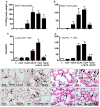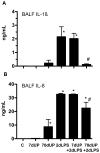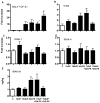Chronic fetal exposure to Ureaplasma parvum suppresses innate immune responses in sheep
- PMID: 21784974
- PMCID: PMC3159703
- DOI: 10.4049/jimmunol.1100779
Chronic fetal exposure to Ureaplasma parvum suppresses innate immune responses in sheep
Abstract
The chorioamnionitis associated with preterm delivery is often polymicrobial with ureaplasma being the most common isolate. To evaluate interactions between the different proinflammatory mediators, we hypothesized that ureaplasma exposure would increase fetal responsiveness to LPS. Fetal sheep were given intra-amniotic (IA) injections of media (control) or Ureaplasma parvum serovar 3 either 7 or 70 d before preterm delivery. Another group received an IA injection of Escherichia coli LPS 2 d prior to delivery. To test for interactions, IA U. parvum-exposed animals were challenged with IA LPS and delivered 2 d later. All animals were delivered at 124 ± 1-d gestation (term = 150 d). Compared with the 2-d LPS exposure group, the U. parvum 70 d + LPS group had 1) decreased lung pro- and anti-inflammatory cytokine expression and 2) fewer CD3(+) T lymphocytes, CCL2(+), myeloperoxidase(+), and PU.1(+) cells in the lung. Interestingly, exposure to U. parvum for 7 d did not change responses to a subsequent IA LPS challenge, and exposure to IA U. parvum alone induced mild lung inflammation. Exposure to U. parvum increased pulmonary TGF-β1 expression but did not change mRNA expression of either the receptor TLR4 or some of the downstream mediators in the lung. Monocytes from fetal blood and lung isolated from U. parvum 70 d + LPS but not U. parvum 7 d + LPS animals had decreased in vitro responsiveness to LPS. These results are consistent with the novel finding of downregulation of LPS responses by chronic but not acute fetal exposures to U. parvum. The findings increase our understanding of how chorioamnionitis-exposed preterm infants may respond to lung injury and postnatal nosocomial infections.
Conflict of interest statement
None of the authors have a commercial interest in any entity related to subject of the manuscript or have a conflict of interest relative to the manuscript.
Figures









References
-
- Mathews TJ, Minino AM, Osterman MJ, Strobino DM, Guyer B. Annual summary of vital statistics: 2008. Pediatrics. 2011;127:146–157. - PubMed
-
- Goldenberg RL, Hauth JC, Andrews WW. Intrauterine infection and preterm delivery. N Engl J Med. 2000;342:1500–1507. - PubMed
-
- Onderdonk AB, Delaney ML, DuBois AM, Allred EN, Leviton A. Detection of bacteria in placental tissues obtained from extremely low gestational age neonates. Am J Obstet Gynecol. 2008;198:110, e111–117. - PubMed
-
- Perni SC, Vardhana S, Korneeva I, Tuttle SL, Paraskevas LR, Chasen ST, Kalish RB, Witkin SS. Mycoplasma hominis and Ureaplasma urealyticum in midtrimester amniotic fluid: association with amniotic fluid cytokine levels and pregnancy outcome. Am J Obstet Gynecol. 2004;191:1382–1386. - PubMed
-
- Gerber S, Vial Y, Hohlfeld P, Witkin SS. Detection of Ureaplasma urealyticum in second-trimester amniotic fluid by polymerase chain reaction correlates with subsequent preterm labor and delivery. J Infect Dis. 2003;187:518–521. - PubMed
Publication types
MeSH terms
Substances
Grants and funding
LinkOut - more resources
Full Text Sources
Medical
Research Materials

